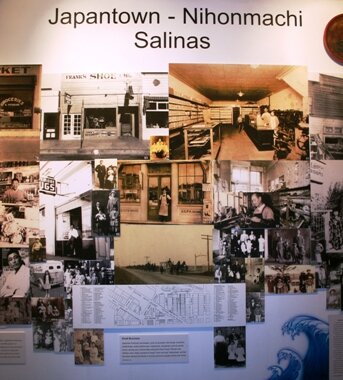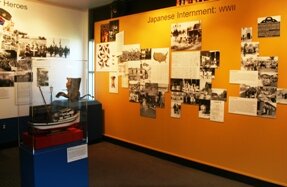By Mae Sakasegawa It has been a privilege and pleasure for Fran Schwann and me to be guest curators of this special exhibition. We also worked closely with Deborah Silguero, curator of the National Steinbeck Center.Through this exhibition, Salinas' Chinatown history continues to be told from the perspective of the Japanese community, as related in the accounts of its members. The exhibition covers the period starting from the late 19th century, when the first Japanese immigrants came to work in the local sugar beet fields, and follows their progress in building a cohesive community through their hard work and perseverance. As you walk through the exhibition, you will get a genuine feel for the vibrant community that once was.From the artifacts and photographs, we have woven a story where you can see the Japanese community grow and start to prosper. You will get a sense that the families were starting to enjoy the fruits of their hard work. And you will learn of the Isseis' determination to make a better life for their children.Their journey took an abrupt turn with the signing of Executive Order 9066 on February 19, 1942, when all Japanese citizens and legal aliens were ordered to evacuate California, Oregon, Washington, and southern Arizona, and sent to concentration camps located in remote areas of the United States. Everything that was carefully built up was suddenly taken away.In a few days Salinas' Japantown simply disappeared. Initially, all were incarcerated in the barracks at the Salinas Assembly Center (rodeo grounds). Then in July, they were moved to Poston, Arizona. To leave the mild climate of Salinas for the Arizona desert, where temperatures exceeded 100 degrees, was unbearable. Salt pills and wet towels were passed out to some of the bewildered internees. Many fainted from the extreme heat. Everyone wondered what would become of them in the middle of this desert.
It has been a privilege and pleasure for Fran Schwann and me to be guest curators of this special exhibition. We also worked closely with Deborah Silguero, curator of the National Steinbeck Center.Through this exhibition, Salinas' Chinatown history continues to be told from the perspective of the Japanese community, as related in the accounts of its members. The exhibition covers the period starting from the late 19th century, when the first Japanese immigrants came to work in the local sugar beet fields, and follows their progress in building a cohesive community through their hard work and perseverance. As you walk through the exhibition, you will get a genuine feel for the vibrant community that once was.From the artifacts and photographs, we have woven a story where you can see the Japanese community grow and start to prosper. You will get a sense that the families were starting to enjoy the fruits of their hard work. And you will learn of the Isseis' determination to make a better life for their children.Their journey took an abrupt turn with the signing of Executive Order 9066 on February 19, 1942, when all Japanese citizens and legal aliens were ordered to evacuate California, Oregon, Washington, and southern Arizona, and sent to concentration camps located in remote areas of the United States. Everything that was carefully built up was suddenly taken away.In a few days Salinas' Japantown simply disappeared. Initially, all were incarcerated in the barracks at the Salinas Assembly Center (rodeo grounds). Then in July, they were moved to Poston, Arizona. To leave the mild climate of Salinas for the Arizona desert, where temperatures exceeded 100 degrees, was unbearable. Salt pills and wet towels were passed out to some of the bewildered internees. Many fainted from the extreme heat. Everyone wondered what would become of them in the middle of this desert. The exhibition takes you on an emotional journey through Camp 2 in Poston, Arizona. It also depicts the ordeals of the 442nd Combat Regiment, the 100th Battalion, and the Military Intelligence Service (MIS), whose members served their country valiantly while their families were incarcerated. We have also incorporated video interviews of internees, presented by students at CSU Monterey Bay.We are pleased that visitors are giving good reviews to this exhibit. Many have said that it gives them an understanding of how the Issei and the Nisei overcame their hardship through their determination and grit.The exhibit also offers a glimpse of Salinas' Nihonmachi and the community that disappeared.--------------------------------------------------------------------The National Steinbeck Center is located at One Main Street, Salinas, CA 93901. The exhibition, Japanese History: In Salinas Chinatown runs until July 17, 2011.
The exhibition takes you on an emotional journey through Camp 2 in Poston, Arizona. It also depicts the ordeals of the 442nd Combat Regiment, the 100th Battalion, and the Military Intelligence Service (MIS), whose members served their country valiantly while their families were incarcerated. We have also incorporated video interviews of internees, presented by students at CSU Monterey Bay.We are pleased that visitors are giving good reviews to this exhibit. Many have said that it gives them an understanding of how the Issei and the Nisei overcame their hardship through their determination and grit.The exhibit also offers a glimpse of Salinas' Nihonmachi and the community that disappeared.--------------------------------------------------------------------The National Steinbeck Center is located at One Main Street, Salinas, CA 93901. The exhibition, Japanese History: In Salinas Chinatown runs until July 17, 2011.





